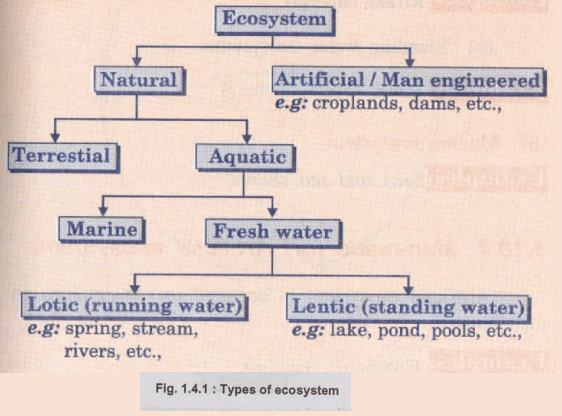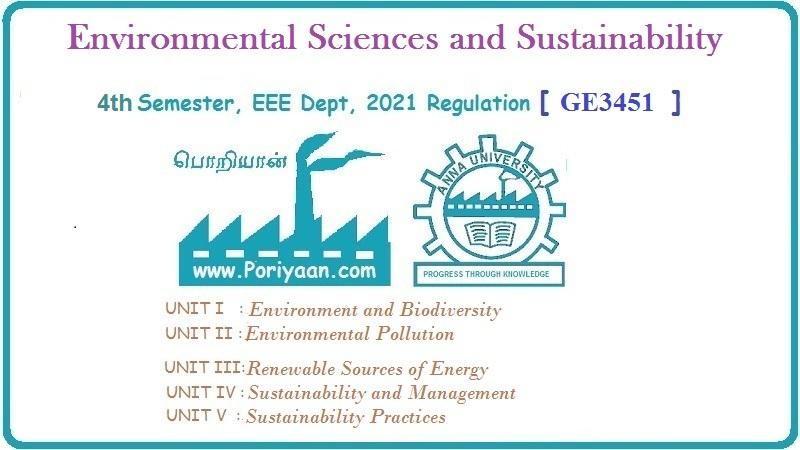Environmental Sciences and Sustainability: Unit I: Environment and Biodiversity
Ecosystems (Structure and Function)
Definitions, Scope, Importance, Classification, Characteristics
3. An ecosystem is a community of living organisms (plants, animals and microbes) in conjunction with the non-living components of their environment (things like air, water and mineral soil), interacting as a system.
Ecosystems (Structure and Function)
•
Ecology is study of interactions among organisms with their environment.
•
The environment consists of both biotic components (living organisms) and
abiotic components (non-living organisms).
•
The terms ecosystems is combination of two words, where 'eco' implies the environment
and 'system' implies an interacting, inter-dependent complex.
Definitions
of Ecosystem
1.
An ecosystem is a group of plants and animals along with physical environment
with which it interacts.
2.
An ecosystem is a community of different species interacting with one another
and with their environment exchanging energy and matter.
3.
An ecosystem is a community of living organisms (plants, animals and microbes)
in conjunction with the non-living components of their environment (things like
air, water and mineral soil), interacting as a system.
4.
An ecosystem is a biological community of interacting organisms and their
physical environment.
Example
:
Grassland ecosystem, aquatic ecosystem, dessert ecosystem etc.
1. Scope and Importance of Ecosystem
Scope
of Ecosystem
•
Our natural landscape consists of forest, river, desert, rocks, minerals and
soil. These landscapes are transformed into villages, town or cities by human
beings.
•
Even though we live in cities, the food grains are supplied from villages
surrounding. It means that our daily life is linked with surrounding
environment. We need water, air to survive and other day-to-day activities
which are part of environment.
•
Human beings are greatly depending on nature or environment. Therefore, environmental
resources like water, trees, minerals, food, energy, land must be preserved in
their natural form.
•
Now a days, because of technological advancements more foods can be grown by
using fertilizers and pesticides, also construction of dams leads to
environmental degradation.
•
Most environmental resources like-water, minerals, petroleum products, wood
etc. are being extracted continuously.
•
Ecologists and environmental scientists have recognised that if these resources
are consumed in this way it will degrade and deplete natural environment.
•
A distinguishing characteristic of many environmental resources is that they
are non- producible: If the natural resource is exhausted, it is not possible
to reproduce them in original form.
•
If we continue to extract them, they may not be available for future
generations.
Importance
of Ecosystem
•
Environmental studies involve multidisciplinary approach. Environmental
resources play a multifunctional role as they command market prices.
•
Any scarce natural resource (rarely available) will cost more as its supply is
less e.g. wood, water.
•
Huge amount of nature's clean water is being polluted and wasted. Waste by
products of chemical process pollute water and gases are polluting air.
•
Deforestation (cutting of trees) leads to increasing environment temperature,
dry rivers, unavailability of fresh air.
•
The accumulated effect of all above factors causes unhealthy atmosphere to
human beings by giving variety of diseases.
•
The misuse or waste of natural resources can be stopped by spreading awareness
to preserve the nature or environment.
•
All must contribute for safeguarding of environment and by preventing
environmental damage.
2. Classification of Ecosystem
•
On the basis of interference and noninterference by man, there exists two types
of ecosystem.
I.
Natural ecosystem. 2. Artificial ecosystem.
1.
Natural ecosystem
•
It operates under natural condition. There is no interference by man at all. It
can be divided further on the basis of habitat.
i)
Terrestrial ecosystem - Forest ecosystem, grassland
ecosystem, dessert ecosystem.
ii)
Aquatic ecosystem - It exists under water. It can be
further divided into two types.
a)
Fresh water ecosystem
-
Running water (river), stream
-
Standing water (lake, pond)
b)
Marine ecosystem
-
Salt water ecosystem.
2.
Artificial / Man made ecosystem
•
These ecosystems are maintained artificially by man where energy is added and
manipulated through planning.
Examples
:
Cropland, gardens aquarium etc.
•
Fig. 1.4.1 shows the ecosystem and its types.

3. Characteristics of Ecosystem
1.
It is structural and functional unit of ecology.
2.
Its structure is related to species diversity i.e. more complex ecosystem have
high species diversity and simple ecosystem have low diversity.
3.
Functions of ecosystem is related to energy flow and cycling of material
involved and within ecosystem.
4.
Ecosystem mature as we pass from less complex to more complex structure i.e.
early stage has excess potential energy and relatively high energy flow per
unit biomass than later stages. It reduces at energy stage.
5.
Alterations in environment represent selective pressures upon populations to
which it must adjust, those which are unable to adjust must disappear i.e.
survival at fittest.
6.
Environment and energy fixation in any ecosystem is limited and constant be
exceeded without serious undesirable effects.
Review Question
1. Give the
classification of ecosystem.
Environmental Sciences and Sustainability: Unit I: Environment and Biodiversity : Tag: : Definitions, Scope, Importance, Classification, Characteristics - Ecosystems (Structure and Function)
Related Topics
Related Subjects
Environmental Sciences and Sustainability
GE3451 ESS 4th Semester | 2021 Regulation | 4th Semester EEE Dept 2021 Regulation
